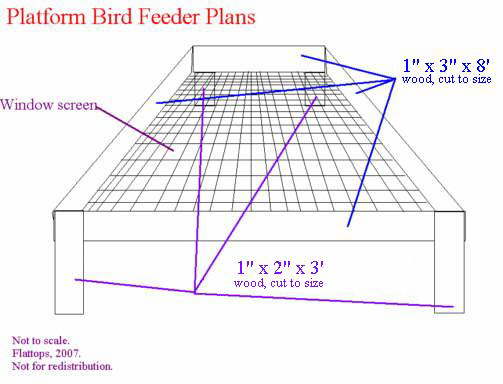
Home
Articles
Awaiting Surgery
Chat
Crafts
Current Events
Fashion
Friends and Family
Fun Stuff
Mailing List
Polls
Profiles
Prostheses
Search
http://flattops.webs.com/Rustic Platform Bird FeederWatching animals has helped me get through some difficult times. Prior to a surgery, a family member and I made this craft to enjoy while recovering, and beyond. Placed so that it can be seen from a window, it offers a cheerful view of nature for convalescents.Platform feeders attract all sorts of wildlife, so if you don't like mammals, too (especially squirrels), don't make this type of feeder! This craft results in an approximately 2' x 2' "table" for wild animals to feed from. I designed it after seeing what type of lumber was available to me, and my original concept was to use basic decking posts (which are 2" x 2" square x 3' long) to cut for the legs, which would look a bit more "polished." Unfortunately, that material wasn't available at the time. If these materials aren't available to you, you can design something different using the same concept, based on what you can find locally. If you don't like a large feeder, change the dimensions. It's a really versatile craft! Cedar is a nice wood to choose, though, because unlike many other woods, it ages nicely. Cedar is the pink-toned wood that people think smells nice--some of our grandmas stored their clothes with cedar. Using window screen in the bottom--rather than wood--helps keep food dryer in inclement weather. Find a screen with small mesh so that smaller seed can be placed in the feeder. Aluminum (silver) or charcoal (black), whatever is your preference. Naughty (and fat!) squirrels may sit inside the feeder. You may want to double-up on the screen used, or put bars across the bottom of the feeder to help support their weight. The feeder is especially fun because, unlike a traditional commercial hopper feeder, so many different kinds of treats can be put on it--even such oddities as in-shell nuts, sunflower seed, millet sprays, fruit, or mealworms . . . or inexpensive feed, like corn (50 pounds of feed corn costs around $5!). The type of feed you choose will help determine what type of guests show up at the feeder, too.
You'll Need:: Cut the 1" x 3" x 8' piece of lumber into four equal 2' sections. Cut the 1" x 2" x 3' piece of lumber into equal 9" sections. Many hardware stores will make these cuts for you for a nominal fee--or for free, if you're lucky--so you do not need to have a saw to make this craft. Once home, the assembly is pretty simple, so I won't bore you with excessive instructions! Use the four two-foot lengths, drill, screwdriver, and screws to make a frame, putting two screws in each connection. Trace the screen. Cut the screen to size. A real carpenter would probably laugh at me, but I carefully put masking tape around the outside of the screen so as not to get cut when stapling it down. Using the stapler, staple it securely to the bottom of the feeder. Remember that the feed will be heavy, so don't skimp on how the screen is secured, and be sure to pull the screen taut. In lieu of a stapler, you can use small nails or screws. Use the smaller wood pieces to make legs. Screw them on to the outside of the frame, using two screws per leg. You may need to put the legs in a bit from the corners so as not to hit the screws going into the frame.  After the frame is completed as in the diagram above, use the left-over wood from creating the legs to make cross-bars underneath the screen, or purchase other braces (such as metal). Heavy animals that may visit, such as squirrels and rabbits, like to sit inside the feeder, which causes the screen to pull off from the frame without this extra support. Place food in the feeder, sit back, and have fun!
Do you have ideas for articles you'd like to see on the site? Did you write an article you'd like to submit? Be sure to send them in. Thank you! This pattern was made by Melissa, March 2007, for Flattops. It cannot be redistributed and is for personal use only. Flattops is not responsible for anything occurring as a result of using this pattern. |